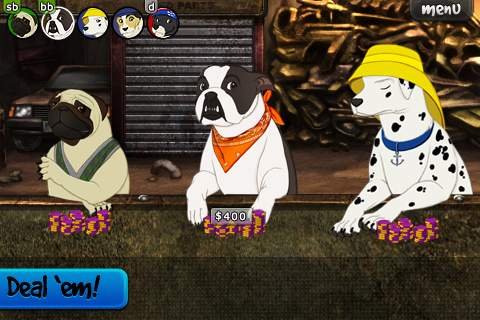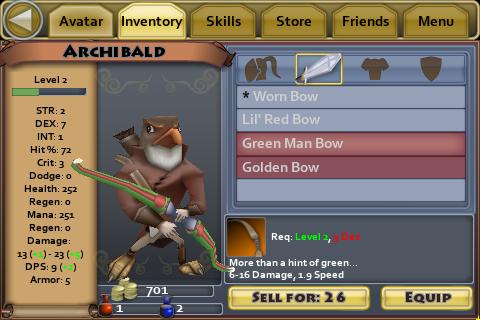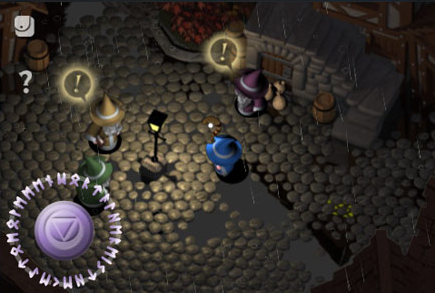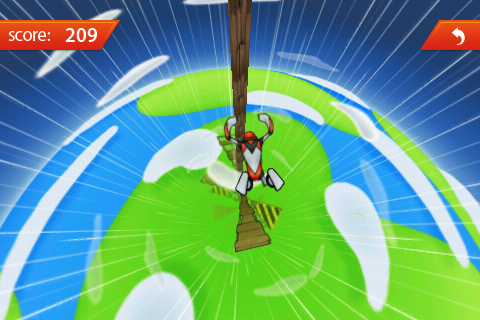Today we bring you an indie interview with Kevin O’Neil, the creator of Dogs Playing Poker!
Company: Candywriter
App Store: Dogs Playing Poker $1.99
How long have you been developing for the iPhone/iPod touch? What did you do before you started developing for the iPhone/iPod touch?
I started Candywriter by developing Mac software in 2006 and instantly became enamored with the Mac community. When Apple announced it was opening up the iPhone to third party developers, we began prototyping immediately and had our first app, Imagine Poker Touch, available on the App Store’s launch day in July 2008. Since then we’ve gradually expanded our interests in the platform and, as of May 2010, have shipped 1.2 million copies of our games via the App Store.
How long did it take you to develop Dogs Playing Poker and how many people were involved?
Dogs Playing Poker piggybacks heavily on our Texas Hold ’em engine from Imagine Poker 2. From a programming perspective, I took the fundamentals out of Imagine and created Dogs Playing Poker in about two months. Our graphics team worked on it for a little while longer. Overall, Dogs Playing Poker was the result of one developer (myself), four artists, one sound guy, one lawyer, and three inspirational dogs!
How did you come up with the idea for Dogs Playing Poker?
My dog, Butkus, is a little thuggish and one day I was lying around looking at him and I thought he epitomized a blue collar poker dog from the infamous C.M. Coolidge paintings. Today his face adorns the Dogs Playing Poker icon!
What inspired you for Dogs Playing Poker from initial concept to formalized game?
We’re an exceptionally creative and humorous group of people are are constantly thinking of new ideas for games. If an idea sticks around long enough for us to start prototyping, it means that we’re really into it and excited for its chances. Dogs Playing Poker was a particularly promising idea as it is self-explanatory, offers built-in curb appeal, and stars man’s best friend!
What inspires you? And is it different for each game?
We’re inspired by our search for the perfect game; I feel like we’re getting a little closer each time and continually learning about how to improve our users’ experience. We’re spending more and more time on the little things, whether its custom UI elements or clever little features like “Every Dog has its Day” – its these creative nuances that keep our interest fresh.
What have you found most difficult about being an indie developer?
Without a doubt the most difficult aspect of life as an indie developer is the marketing. Its a community of established players, indie cliques, garage developers, moonlighters, and big money investors and the key to each of these parties’ success is the exposure. Its tough to stand out amidst the intense competition.
Can you describe your development process?
We use a rapid application development (RAD) model and start with loose designs and then iterate. We’re able to pull this off because we’re extremely agile, efficient, and motivated.
What does the creative process look like during the initial stages?
Its actually pretty unstructured. We do mockups and discuss extensively but we know that our best ideas come as a result of iterating.
Did you do any pre-marketing before Dogs Playing Poker was released?
We released a very high quality teaser trailer about a month before the Dogs Playing Poker launch and it was noticed and covered by a number of review sites and blogs. We also updated our other apps (user base > 500k) and, in the update blurbs, let people know about our upcoming hit. This strategy ended up paying dividends when Dogs Playing Poker finally hit the App Store.
What are you working on now?
We’re huge believers in the Mac and are hard at work on a Mac version of Dogs Playing Poker. We’re also busy with a sequel to our smash hit word game, Word Solitaire.
Any plans for updates to Dogs Playing Poker?
Absolutely. The reception to Dogs Playing Poker has been amazing but there’s still work to be done. I can’t say enough good things about our loyal users – their iTunes reviews are where we look to figure out where DPP must go next.
What was your most frustrating task while developing Dogs Playing Poker?
There’s only one thing that frustrates me about developing anything on the iPhone and that’s testing on an original (2G/Edge) iPhone! I use an iPhone 3GS and a third gen iPod touch as primary development devices and I’m such a speed fiend that my hands fill with sweat when I think about testing on an older device and watching everything slow down. I recognize that its stuff most people will never notice but the little animation lags drive me bananas (B-A-N-A-N-A-S). I can’t wait for the day when everyone is running speedier hardware.
What have you found to be the most successful way to market Dogs Playing Poker?
The innate curb appeal of an idea like Dogs Playing Poker sells itself. Cross-promotion and getting some attention from the review sites helps but even if the Pope himself tattooed your app’s name across his forehead, it wouldn’t compare to a feature from Apple. We were lucky enough to catch Apple’s eye with Dogs Playing Poker and doing so made the game an overnight success, literally.
How much does user feedback affect your planning of updates and also future projects?
User feedback is huge. We have ideas of our own but once you see two or more users make the same criticism on iTunes, you know you’re missing something important.
Do you write games for yourself or for others? And why?
We write games for ourselves because life is short and the self-fulfillment associated with publishing our own ideas is unparalleled. Thankfully, enough people appreciate our visions to keep us in business!
What process do you go through to overcome creative block?
Creative block is fortunately not a problem for us.
Since its release what you do differently looking back?
I am in the rare and admittedly enviable position to say that I wouldn’t have done anything differently. Dogs Playing Poker is on the top of the Card and Casino categories and among the highest charting card games since the App Store opened.
What was the development atmosphere like? What kind of music did you listen to?
Like brains fuel zombies, trance fuels Candywriter. Podcasts like Dance Department, Gareth Emery.
What was a must have during the development process of Dogs Playing Poker?
Patience, attention to detail, and a love for dogs!
What games influenced you in your decision to make Dogs Playing Poker?
The success of our own Imagine Poker gave us the confidence to invest in Dogs Playing Poker. In Imagine Poker, instead of dogs you face off against characters from history like Napoleon, Cleopatra, and Genghis Khan. I thought we could make a “mainstream” version of that game.
How close was the end product to your initial conceptualization?
In all honesty, it came out nicer than we imagined.
Before the release of Dogs Playing Poker were there any huge last minute changes?
Not really.
How did you keep yourself motivated?
“Choose a job you love, and you will never have to work a day in your life.” – Confucius
How much did the art drive the game? The vision of what it was to look like how much of that was the driving force?
The art was huge. We pride ourselves on pixel-perfect graphics and the more you add to the game, the more excited you become to show the world.
What tools of the trade are a must have for you when it comes to programming, art and music?
Xcode, Photoshop, TextWrangler, SoundStudio, Springy, Skype, Fetch, Snapz Pro
If you were stuck on an island with a laptop and no internet access what apps would you have loaded?
I think TextEdit could have helped Robinson Crusoe.
Is there anything else that you would like to say?
Thanks for taking the time to find out a little more about Candywriter!
We want to thank Kevin for his time and the great work that he and his team are doing!
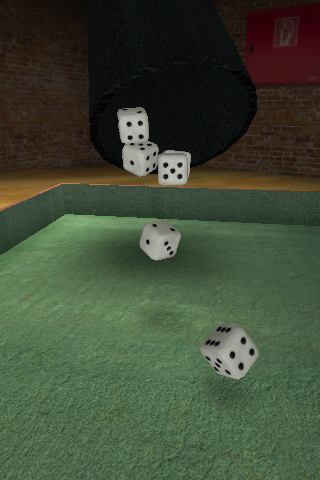 Mark Hessburg
Mark Hessburg